Improving survival in twin-twin transfusion syndrome
Although serial amnioreduction is still widely used to treat this dangerous condition, a recent randomized trial found that when compared to amnioreduction at 15 to 26 weeks, overall perinatal survival is higher with laser ablation, which tries to reverse the disease process.
Twin-twin transfusion syndrome (TTTS), sometimes called "stuck twin syndrome," is an often fatal complication of monochorionic (MC) twin pregnancies. Untreated, the vast majority of fetuses with severe TTTS before 26 weeks' gestation will die.1 TTTS appears to result from a net unbalanced flow of blood between two fetuses in a monochorionic placenta that leads to one fetus (the "recipient") becoming hypervolemic with polyhydramnios at the expense of its sibling (the "donor"), which develops hypovolemia and eventual oligohydramnios.
Twinning in the United States continues to increase (with an incidence of 31.5 per 1,000 live births).2 Two things are behind this rising trend: greater use of assisted reproductive technologies (ART) and delayed conception in older women. Both have led to an increased frequency of dizygotic (fraternal) twins. In addition, ART techniques such as assisted zygote hatching can increase monozygotic twinning by up to eightfold.3
Roughly one third of twins are monozygotic (identical); two thirds of these are monochorionic (MC). Note the Figure 1 ultrasound depiction of a donor ("stuck") twin and recipient twin in the polyhydramnios sac. TTTS occurs in 15% to 20% of MC diamniotic (DA) twins. Based on 2003 CDC data, the theoretical incidence of TTTS would be 1.38 to 1.86 cases in every 1,000 live births or roughly up to 7,500 cases annually in the US.3 One Australian study, however, noted an incidence of only 1 in 4,170 pregnancies or 1 in 58 twin gestations.4 This difference between estimated and observed incidence of TTTS may be partly explained by the "hidden mortality" associated with MC multifetal pregnancies-cases that are lost due to premature rupture of membranes (PROM) or intrauterine fetal demise before a diagnosis of TTTS can be made.5
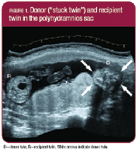
TTTS now defined differently
TTTS used to be defined by neonatal parameters, specifically differences in birthweight or cord hemoglobin at the time of delivery.6 We now know, however, that discordant fetal weights will often be a late manifestation, and fetal hemoglobin through cordocentesis is often equivalent in the twin pair even in severe TTTS.7 [With the widespread use of U/S, specific criteria have been established for the prenatal diagnosis of TTTS, including same-sex fetuses, a single placenta, and a lack of lambda or "twin peak" sign in early pregnancy] (Figure 2, Table 1). Markers of monochorionicity must be accompanied by oligohydramnios in the donor twin and polyhydramnios in the recipient.
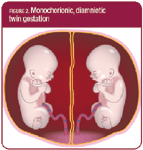
Five stages of TTTS have been proposed based on U/S findings8:
Stage I: Oligohydramnios (maximum vertical pocket (MVP) <2 cm) and polyhydramnios (MVP >8 cm before 20 weeks' gestation; >10 cm after 20 weeks' gestation) but a bladder is still visible in the donor twin.
Stage II: Discordant amniotic fluid volumes with the bladder not seen in the donor twin on U/S.
Stage III: Doppler blood flow studies showing absent/reverse end-diastolic velocity in the umbilical artery, reversed flow in the ductus venosus, or pulsatile flow in the umbilical vein in either fetus.
Stage IV: One or both fetuses show signs of hydrops.
Stage V: One or both fetuses have died.

Understanding the pathophysiology
Postnatal examination of MC placentas tells us that vascular anastomoses are present in virtually all cases. The communications may be one of four types. Arteriovenous (donor → recipient) and venoarterial (recipient → donor) are anastomoses located in the capillary bed deep within the placental cotyledon. Arterio-arterio (AA) or venous-venous (VV) anastomoses are located on the placental surface (Figures 3 and 4). [While no one has yet identified the precipitating event leading to clinical TTTS, in 15% to 20% of MC gestations it appears that the major components in that cascade of events are an imbalance in the AV anastomoses and the absence of bidirectional AA communications.9]
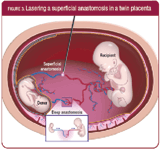
The name "twin-twin transfusion syndrome" implies that one twin fetus transfuses the other with blood. But this clearly oversimplifies the situation. Studies have shown that transfused adult red cells can be found in the recipient twin soon after they've been administered intravascularly to the donor.10 This establishes the concept that vasoactive substances can be actively transferred between the twin pair. The donor twin is probably the twin fetus who suffers the initial insult. In response to hypovolemia, the twin produces more antidiuretic hormone and renin in an attempt to increase its intravascular volume. This results in less urine production, oligohydramnios, eventually anhydramnios, and a "stuck twin."
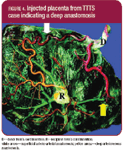
The recipient twin, on the other hand, appears to suffer paradoxical responses to the vasoactive mediators. Elevated levels of atrial naturietic hormone result in polyuria and polyhydramnios. Increased peripheral vascular resistance, hypertension, right-sided heart failure, and ultimately hydrops fetalis have been attributed to increased endothelin-1 in the recipient.11
A dismal prognosis
Without intervention, the vast majority of fetuses (90%) presenting with severe TTTS prior to 26 weeks' gestation end with fetal demise of one or both twins. In the event of a singleton death, neurologic compromise will be seen in more than 25% of the surviving co-twins.12 In the past, thromboplastic substances released from the dead twin were thought to cause these changes. But it's now believed that due to a falling blood pressure in the dying twin, it serves as a "sink" for the blood volume of its sibling. This eventually causes acute hypotension and anemia in the surviving twin, which lead to neurologic injury.13
In general, more advanced stages of TTTS (III and IV) are associated with higher perinatal mortality. Twins at earlier stages (I and II) may remain stable, regress, or move rapidly to a more advanced stage. Therefore, staging in its present form provides information that will help determine the need for intervention but will not necessarily predict disease progression.
Early U/S monitoring
[Determine chorionicity as soon as you first detect a twin gestation, ideally establishing placentation in the first trimester when U/S assessment is most accurate.] When two distinct placentas are not clearly seen, you should establish dichorionic placentation by assessing for the "twin peak" or "lambda" sign; its absence is a marker for the MC gestation. In the second trimester, a thin intervening inter-twin membrane, a single placenta, and same-sex fetuses indicate an MC gestation. The twin gestation should undergo a comprehensive U/S at 18 weeks' gestation, because monozygotic twins tend to have more structural anomalies; discordance for these anomalies is not uncommon. Thereafter, given the increased risk of TTTS and the disorder's unpredictable nature, obtain U/S assessment of amniotic fluid volumes (AFV) and fetal bladder size every 2 to 3 weeks in MC multifetal pregnancies. Fetal growth evaluations should be obtained every 4 weeks. If early signs of TTTS are detected, you should refer the patient to a maternal-fetal medicine specialist for further evaluation, Doppler blood flow assessment, weekly U/S, and possible intervention. Serial amnioreduction and septostomy have been used to treat polyhydramnios, the primary presenting sign of TTTS. More recently, laser ablation of the anastomotic placental vessels and selective fetocide have been used to actually reverse the disease process.
Still a place for amnioreduction?
[Once the mainstay of therapy, serial amnioreduction is still widely used to treat TTTS.] A palliative measure, amnioreduction is undertaken to normalize AFV and reduce the likelihood of preterm delivery from polyhydramnios in the recipient twin. Unfortunately, amnioreduction does not disrupt the underlying pathologic process. Although an overall perinatal survival rate of 60% at 4 weeks of neonatal age has been reported, most of these cases presented later in gestation with early-stage disease.14 Amnioreduction for severe TTTS prior to 26 weeks' gestation rarely results in significantly improved perinatal survival.15 In addition, the treatment may cause the chorion and amnion to separate, thereby making more definitive therapy, such as laser ablation, more difficult. [Amnioreduction therefore should be reserved for those cases presenting before 26 weeks that can't be treated with laser ablation and for stage I or II disease presenting after 26 weeks' gestation.]
Septostomy
The purposeful puncture of the intervening twin membrane in cases of TTTS is called septostomy or microseptostomy. In the only randomized controlled trial, the perinatal survival rates with serial amnioreduction versus septostomy were equal; however, the patients in the septostomy group required fewer repeat procedures.16 Concerns have been raised that this procedure may extensively disrupt the membrane between the twins, leading to an iatrogenic monoamniotic twin gestation and the possibility of entangled umbilical cords. In the randomized trial, there was one case in each study group of significant disruption of the inter-twin membrane allowing both twins to share one amniotic sac.16 [Like amnioreduction, septostomy treats only the underlying polyhydramnios but does not treat the mechanisms that cause TTTS.] Should one twin die, the surviving twin remains at risk for neurologic injury.
Laser ablation
First introduced in 1990, laser ablation of the communicating placental plate vessels under direct visualization with a fetoscope has now gained acceptance as an effective treatment for severe TTTS (Figures 3 and 5).17
The surgeon selects a site of entry away from the placenta that provides access to the inter-twin membrane through the recipient twin's sac. Under continuous U/S guidance, a 10 to 14F cannula is used as the single port of entry through which to insert the operating sheath containing a fetoscope (endoscope) as well as a 400- or 600-micron YAG or diode laser fiber. Under direct visualization, placental vessels are systematically mapped from the recipient's umbilical cord root to their ending at the vascular equator. The goal is to selectively identify deep AV and superficial anastomoses between the fetuses. Communicating vessels are obliterated using 30 to 60 W of laser energy.
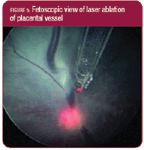
A recent randomized trial, the Eurofetus study, found an overall perinatal survival of 76% (survival of at least one fetus) with laser ablation as compared to 56% with serial amnioreduction.18 Intact neurologic survival was 52% in the laser group versus 31% in the amnioreduction group. In addition, this study showed that should one twin die after laser therapy, thanks to the previous closure of the communicating placental vessels, its sibling's chances of developing neurologic complications are reduced fivefold. The authors of an accompanying editorial summarized the study results this way: Following laser photocoagulation, one third of treated cases will have no survivors, one third will have one intact survivor, and one third of cases result in two intact survivors.19
A recent follow-up study of surviving children at up to age 3 revealed that 87% had a normal neurologic outcome, while 7% had minor neurologic abnormalities, and 6% had major abnormalities following laser photocoagulation for severe TTTS.20
Laser therapy is now advocated as the initial intervention for stage II-IV TTTS presenting prior to 26 weeks' gestation. However, recent reports suggest that laser ablation may be a more appropriate intervention for stage IV disease than preterm delivery even later in gestation, considering the grim prognosis associated with neonatal hydrops before 30 weeks' gestation.21
Selective fetocide
[In some severe cases of TTTS, selective fetocide may be the treatment of choice. Examples are stage IV disease with hydrops and poor cardiac function in the recipient twin, stage III disease with massive polyhydramnios and cervical shortening at a gestational age that is remote from viability, or at any stage disease where one twin is found to have a secondary malformation.22] A 3-mm disposable bi-polar forceps can be introduced into the amniotic cavity of the targeted fetus; thermal occlusion is then performed at two or three sites on the umbilical cord. Failure of this technique is rare; roughly 80% to 85% of co-twins can be expected to survive. PROM is the most common complication, occurring in 20% to 25% of cases. An alternative technique, radiofrequency ablation (RFA) using a specialized 17-g needle, may prove to be the most effective means of thermal occlusion. Preliminary reports, while limited to pregnancies complicated by acardiac twinning, have noted successful occlusion in all cases with PROM rates below 5%.23 However, the overall rates of success and procedure-related complications after selective fetocide with RFA for other forms of complicated MC multifetal pregnancies remain unknown.
Severe TTTS is probably underreported as a complication of MC twin gestations. [Although the pathophysiology of this disorder remains to be completely unraveled, newer treatments such as laser ablation of placental anastomoses and selective fetocide hold promise for improving perinatal outcome.]
FREE ONLINE CME
To earn CME credit for this article, participants should read the article and log onto http://www.contemporaryobgyn.net, where they must pass a post-test. After completing the test and online evaluation, a CME credit letter will be e-mailed to them. The release date for this activity is December 1, 2006. The expiration date is December 1, 2007.
CME Learning objectives
Upon completion of this article, participants will be able to:
- Use specific ultrasound-based criteria to diagnose twin-twin transfusion syndrome (TTTS) as early as possible, thereby facilitating referral to a maternal-fetal medicine specialist.
- Evaluate which of the five recognized stages of twin-twin transfusion syndrome apply to a patient's twin fetuses, realizing that staging information can help determine need for intervention but does not necessarily predict disease progression.
- Restate the roles of amnioreduction and septostomy and the pros and cons of newer TTTS treatment modalities, such as laser ablation of placental anastomoses and selective fetocide, based on available research.
Accreditation
This activity has been planned and implemented in accordance with the Essential Areas and Policies of the Accreditation Council for Continuing Medical Education through the joint sponsorship of AHC Media LLC and Contemporary OB/GYN. AHC Media LLC is accredited by the ACCME to provide continuing medical education for physicians.
AHC Media LLC designates this educational activity for a maximum of 1 AMA PRA Category 1 Credit™. Physicians should only claim credit commensurate with the extent of their participation in the activity.
Target audience
Obstetrician/gynecologists and women's health practitioners.
Disclosures
The authors of this article and the manuscript reviewer report no relationships with companies having ties to this field of study. The reviewer discloses that he is a retained consultant for Adeza Biomedical. Dr. Johnson discloses that he is a retained consultant for PerkinElmer LAS, Inc., and Dr. Moise discloses that he is a paid consultant for Sequenom, Inc.-both with regard to genetic test development. The editors (Judith M. Orvos, Elizabeth A. Nissen, and Paul L. Cerrato) disclose that they do not have any financial relationships with any manufacturer in this therapeutic category.
DR. JOHNSON is Associate Professor of Obstetrics and Gynecology and DR. MOISE is Professor of Obstetrics and Gynecology, Department of Obstetrics and Gynecology, Division of Maternal-Fetal Medicine, Baylor College of Medicine, Houston, Tex. Both are members of the Texas Children?s Fetal Center.
REFERENCES
1. Saunders NJ, Snijders RJ, Nicolaides KH. Therapeutic amniocentesis in twin-twin transfusion syndrome appearing in the second trimester of pregnancy. Am J Obstet Gynecol. 1992;166:820-824.
2. Martin JA, Hamilton BE, Sutton PD, et al. Births: Final data for 2003. Natl Vital Stat Rep. 2005;54:1-116.
3. Saito H, Tsutsumi O, Noda Y, et al. Do assisted reproductive technologies have effects on the demography of monozygotic twinning? Fertil Steril. 2000;74:178-179.
4. Dickinson JE, Evans SF. Obstetric and perinatal outcomes from the Australian and New Zealand twin-twin transfusion syndrome registry. Am J Obstet Gynecol. 2000;182:706-712.
5. Sebire NJ, Snijders RJ, Hughes K, et al. The hidden mortality of monochorionic twin pregnancies. Br J Obstet Gynaecol. 1997;104:1203-1207.
6. Wenstrom KD, Tessen JA, Zlatnik FJ, et al. Frequency, distribution, and theoretical mechanisms of hematologic and weight discordance in monochorionic twins. Obstet Gynecol. 1992;80:257-261.
7. Fisk NM, Borrell A, Hubinont C, et al. Fetofetal transfusion syndrome: do the neonatal criteria apply in utero? Arch Dis Child. 1990;65:657-661.
8. Quintero RA, Morales WJ, Allen MH, et al. Staging of twin-twin transfusion syndrome. J Perinatol. 1999;19:550-555.
9. Taylor MJ, Denbow ML, Tanawattanacharoen S, et al. Doppler detection of arterio-arterial anastomoses in monochorionic twins: feasibility and clinical application. Hum Reprod. 2000;15:1632-1636.
10. Tanaka M, Natori M, Ishimoto H, et al. Intravascular pancuronium bromide infusion for prenatal diagnosis of twin-twin transfusion syndrome. Fetal Diagn Ther. 1992;7:36-40.
11. Galea P, Jain V, Fisk NM. Insights into the pathophysiology of twin-twin transfusion syndrome. Prenat Diagn. 2005;25:777-785.
12. Fusi L, Gordon H. Twin pregnancy complicated by single intrauterine death. Problems and outcome with conservative management. Br J Obstet Gynaecol. 1990;97:511-516.
13. Okamura K, Murotsuki J, Tanigawara S, et al. Funipuncture for evaluation of hematologic and coagulation indices in the surviving twin following co-twin's death. Obstet Gynecol. 1994;83:975-978.
14. Mari G, Roberts A, Detti L, et al. Perinatal morbidity and mortality rates in severe twin-twin transfusion syndrome: results of the International Amnioreduction Registry. Am J Obstet Gynecol. 2001;185:708-715.
15. Gonsoulin W, Moise KJ Jr, Kirshon B, et al. Outcome of twin-twin transfusion diagnosed before 28 weeks of gestation. Obstet Gynecol. 1990;75:214-216.
16. Moise KJ Jr, Dorman K, Lamvu G, et al. A randomized trial of amnioreduction versus septostomy in the treatment of twin-twin transfusion syndrome. Am J Obstet Gynecol. 2005;193:701-707.
10. De Lia JE, Cruikshank DP, Keye WR Jr. Fetoscopic neodymium:YAG laser occlusion of placental vessels in severe twin-twin transfusion syndrome. Obstet Gynecol. 1990;75:1046-1053.
18. Senat MV, Deprest J, Boulvain M, et al. Endoscopic laser surgery versus serial amnioreduction for severe twin-to-twin transfusion syndrome. N Engl J Med. 2004;351:136-144.
19. Fisk NM, Galea P. Twin-twin transfusion-as good as it gets? N Engl J Med. 2004;351:182-184.
20. Graef C, Ellenrieder B, Hecher K, et al. Long-term neurodevelopmental outcome of 167 children after intrauterine laser treatment for severe twin-twin transfusion syndrome. Am J Obstet Gynecol. 2006;194:303-308.
21. Ryan G, Windrim R, Alkazaleh F, et al. Severe twin-twin transfusion syndrome (TTTS)-is there a role for laser beyond the conventional gestational age guidelines? Ultrasound Obstet Gynecol. 2006;28:381-382.
22. Taylor MJ, Shalev E, Tanawattanacharoen S, et al. Ultrasound-guided umbilical cord occlusion using bipolar diathermy for Stage III/IV twin-twin transfusion syndrome. Prenat Diagn. 2002;22:70-76.
23. Tsao K, Feldstein VA, Albanese CT, et al. Selective reduction of acardiac twin by radiofrequency ablation. Am J Obstet Gynecol. 2002;187:635-640.
